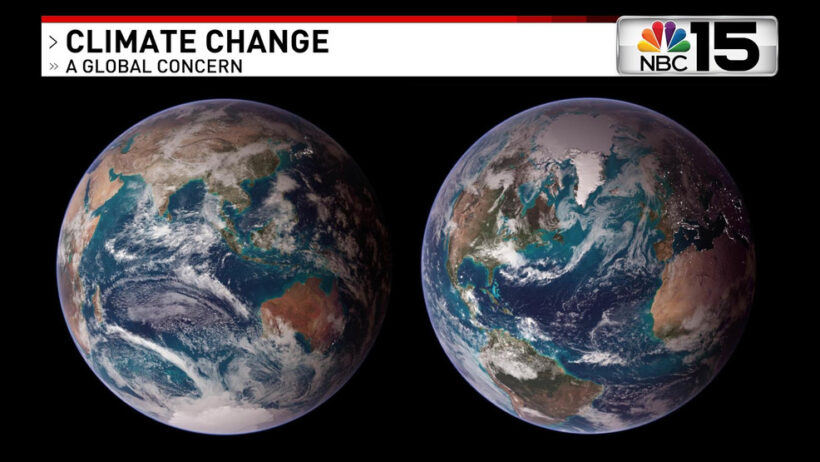The climate on Earth is a complex and dynamic system that governs not only weather patterns but also shapes the ecological and evolutionary landscapes of our planet. The intricate interactions between the atmosphere, hydrosphere, biosphere, and lithosphere create a multitude of climatic zones, each with its unique characteristics. Understanding the climate of our blue planet requires an exploration into meteorological phenomena, shifting patterns, and the intricate balance of natural systems.
To commence, it is crucial to discern the distinction between climate and weather. Weather pertains to the short-term atmospheric conditions in a specific area—forecasting rain for the weekend, or snow for a holiday season. Conversely, climate represents the long-term average of temperature, humidity, wind, and precipitation patterns over extended periods, typically 30 years or more. This broader perspective elucidates how environments evolve, revealing trends that inform us about the natural world.
Earth’s climate is predominantly influenced by the sun’s energy, which warms the planet’s surface and drives atmospheric circulation. Solar radiation warms the equatorial regions more intensely than the poles, leading to temperature differentials that result in the formation of wind patterns. The Coriolis effect further complicates these patterns, causing air to spiral instead of traveling straight, thus generating trade winds and ocean currents that significantly contribute to the climate systems of our planet.
One of the most captivating characteristics of Earth’s climate is its heterogeneity. The planet is home to an array of climatic regions, from the arid deserts of the Sahara to the frigid tundras of Antarctica. Each region fosters unique ecosystems and biodiversity, which have adapted to specific climatic conditions. For instance, the rainforests of the Amazon thrive in warm, humid conditions whereas the Great Plains are characterized by dry, continental climates conducive to grassland formation. This distinctive zoning raises a fundamental question: Why do certain regions experience specific climates, and how does this affect life on Earth?
Delving deeper, it becomes evident that geography plays a fundamental role in climate formation. Latitude, topography, and proximity to bodies of water are key determinants. Areas near the equator receive more direct sunlight throughout the year, fostering tropical climates. Conversely, polar regions experience less direct sunlight, yielding icy environments. Additionally, mountain ranges can block moist air currents, creating rain shadows leading to arid conditions on one side while nurturing lush forests on the other. Such geographic intricacies add layers of complexity to our understanding of the climate.
However, the climate is not static. Instead, it is subject to fluctuations brought about by both natural processes and anthropogenic influences. Earth has experienced various climatic epochs throughout its history, including ice ages, warmer interglacial periods, and profound shifts in precipitation patterns. These changes often correlate with alterations in greenhouse gas concentrations, volcanic activity, and solar radiation cycles. The current challenge lies in the anthropogenic influences that have led to unprecedented changes in the climate system.
The industrial revolution catalyzed a significant rise in carbon emissions due to fossil fuel combustion, resulting in an increase in atmospheric greenhouse gases. This escalation in greenhouse gases enhances the greenhouse effect, where heat is trapped in the atmosphere rather than being radiated back into space. Consequently, global temperatures have risen, altering existing climate patterns—an effect that is now palpable across the globe.
The manifestations of climate change are becoming increasingly evident. Extreme weather events, including hurricanes, droughts, and heatwaves, are intensifying; sea levels are rising due to melting ice caps and thermal expansion of seawater; and ecosystems are undergoing shifts as species seek refuge in more hospitable environments. The delicate equilibrium that sustains life on this planet is being tested, leading to urgent calls for global action.
Despite the grave implications of climate change, there are glimmers of hope. Awareness and scientific understanding of our climatic crossroads have spurred movements advocating for sustainability and climate action. Communities worldwide are mobilizing to adopt renewable energy technologies, enhance resilience through environmentally sustainable practices, and mitigate emissions on local and global scales. This cohesive global effort highlights humanity’s relationship with the environment, illustrating that our actions do indeed have consequences.
Furthermore, the fascination with Earth’s climate is not solely a scientific endeavor; it invites philosophical contemplation about our responsibility. The reverence for nature is deeply ingrained in our consciousness, urging us to ponder our place within the fragile tapestry of life. As stewards of the planet, we are called to acknowledge our interdependence with its systems, prompting a deeper appreciation for the delicate balance that sustains us.
In conclusion, the climate on Earth is an intricate interplay of various elements that fosters diverse ecosystems and drives weather patterns. Understanding this complexity is essential in addressing the pressing issue of climate change, which threatens the very fabric of life as we know it. Cultivating awareness, advocating for sustainable practices, and fostering a global commitment to mitigating climate impacts remain imperative as we navigate the complexities of our ever-changing blue planet.






